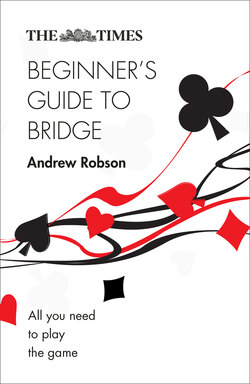Читать книгу The Times Beginner’s Guide to Bridge - Andrew Robson - Страница 6
ОглавлениеIntroduction
Welcome to bridge
Bridge is possibly the best game devised by mankind – and certainly one of the most popular. But a word of warning: you’ll soon be hooked. Fortunately, this need not be expensive and will be good both for your brain and your social life.
First steps
This book will please complete beginners, as no assumption of prior knowledge has been made. It’s also suitable for those who play social ‘kitchen’ bridge and want to develop their game.
The first chapter (‘Appetiser’) starts from scratch. By the end of it you’ll understand the essence of the game and be able to play, though at a rudimentary level. Those who have played before may prefer to skim this part of the book. The second chapter (‘Basics’) gives guidelines for bidding and card play. Work through this and you’ll have done the equivalent of completing the eight-week beginner course at my bridge club. In the third chapter (‘Core’), each area of the game is considered in more detail, taking you to intermediate-level bridge. Chapter 4 (‘Development’) takes things further, revealing the ingenuity – and sheer beauty – of the game. Finally, you’ll find information on scoring in chapter 5, and details of different types of bridge and bidding styles.
My suggestion is to read chapters 1 and 2, then try to get some practice – even if it’s just dealing out cards by yourself (a very stimulating and productive thing to do). At this stage, although probably not the strongest player at the table, you’ll be able to play a perfectly adequate game of social bridge; best of all, you’ll be having fun. When you’re ready, move on to chapters 3 and 4, using chapter 5 as a reference when you want to know more about scoring.
must know
The best way to learn to play bridge is to set realistic goals, reinforce your knowledge and slowly build your skills. Most important of all is to enjoy playing.
A short history
A trick-taking game, bridge evolved from whist, which has been played for centuries. The first book devoted to whist, Edmond Hoyle’s Short Treatise, appeared in 1742 and became a bestseller.
No one knows the roots of the name ‘bridge’. It may have evolved from ‘biritch’, the name of a Russian game with similar rules, or possibly the Turkish term ‘bir uc’, meaning ‘one-three’ – as in one exposed hand and three concealed ones.
In 1903 British civil servants in India developed the practice of bidding for the privilege of naming the trump suit, thus introducing ‘Auction bridge’. ‘Contract bridge’, the universally played modern form, was only formally invented in 1925: not in a seedy back room, but on an American cruise ship under the guidance of Harold Vanderbilt. US marketer Ely Culbertson soon popularized the game, and by 1930 it was the society activity on both sides of the Atlantic. Since those first heady days, bridge has made front-page news – when a famous British pair, Reese and Schapiro, were accused of cheating in 1965. It has attracted film stars – Omar Sharif played at the top level – and featured in many books, perhaps the most famous of all being Ian Fleming’s Moonraker. Bill Gates and Warren Buffett are keen bridge players, and if they give just a small fraction of their wealth back to the game, we can look forward to a very bright future, especially as bridge is now more widely accessible than ever – via the internet.
Useful tip
Bridge is a ceaselessly fascinating and stimulating game. Start playing by partnering someone more experienced than you, who can help you get the most out of your play.
